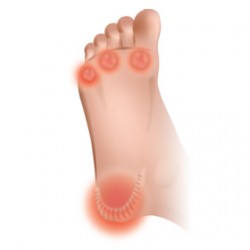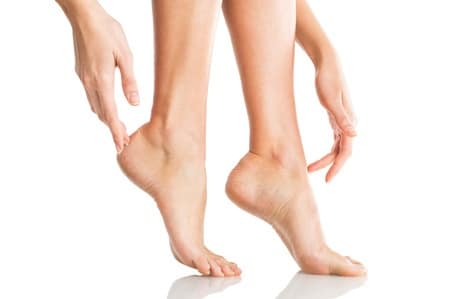Calluses are a very common type of foot complaint, and it’s highly likely you’ll develop a callus at some point in your life. In fact, although unsightly, calluses are simply your body’s way of protecting itself against friction, and are certainly not considered a major health issue.
What Exactly Are Calluses?

Quite simply, calluses form when the foot is subjected to undue pressure, friction or resistance. You’ll be able to identify whether or not you have a callus fairly easily; as they form a distinctive hard ‘lump’ on the foot, which often feels rough to touch.
Calluses are generally found on the heel, on the side of your big toe, or on the ball of your foot. This is due to the fact that these areas most commonly encounter friction and pressure caused by footwear.
What Are the Symptoms?
It’s unlikely that you’ll experience much pain with a callus; though they can occasionally cause minor discomfort; not to mention look somewhat unattractive, particularly when wearing strappy shoes or flip-flops!
These are the common symptoms of calluses:
- Excess skin. As your skin fights to repair itself after damage from friction or pressure, it forms excess skin, which will rise above the surrounding skin, forming a lump.
- Hardness. It’s likely that your callus will feel hard when touched, and it’s also likely to feel rougher than the rest of your foot.
What is Causing Your Calluses?
There are many different reasons why you may have calluses.
- Ill-fitting shoes. If your shoes force your feet into a position where excess pressure is exerted in a particular location, then it’s highly likely you’ll develop a callus. The main offenders are high-heeled shoes, which create extra pressure on the ball of the foot. Likewise, if your shoes are too small for you, it may create rubbing and friction on the skin, which can also lead to a callus.
- Abnormal gait. Your calluses could be caused by the way you’re walking, especially if you’re putting undue pressure on a particular part of the foot. The best way to assess if your gait is normal or not is to book an appointment to have your gait analysed, using professional equipment.
- Flat feet or high arches. If you suffer from flat feet or high arches, pressure won’t be distributed evenly along the foot, which also causes calluses.
How to Treat Calluses
Thankfully, calluses are relatively easy to eliminate. If you book an appointment with your local Foot Solutions store, an expert will be able to recommend a suitable callus relief product, in addition to assessing your gait and ascertaining the underlying causes of your calluses.
It’s also recommended that you rethink your footwear, particularly if you wear high heels on a regular basis. If you don’t like the thought of being without your heels, shock-absorbing inserts may help to ease the pressure on your feet.
To arrange an appointment with your local Foot Solutions store in Ireland, simply visit the site today.

































